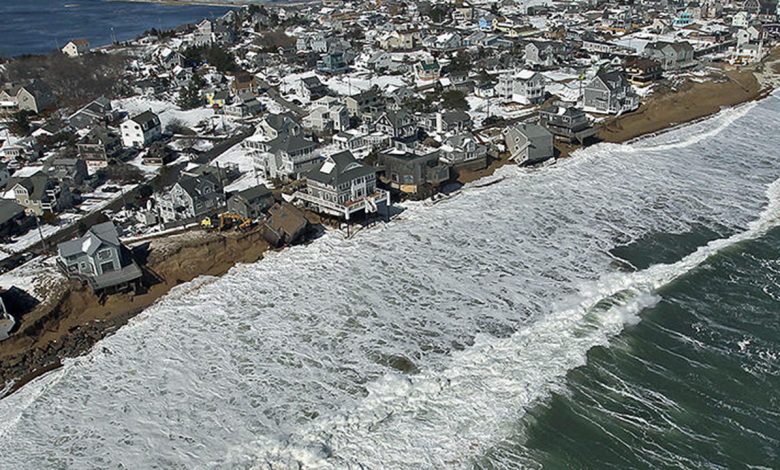Daily Current Affairs for UPSC
Global Sea-level Rise and Implications
Syllabus- Government Policies and Interventions [GS Paper-2]

Context- The World Meteorological Organization (WMO) released the report “Global Sea-level Rise and Implications” recently.
Key Highlights
- Sea level rise dangers:
-
-
- Sea-level rise poses the greatest threat to Bangladesh, India, India, Bangladesh, and the Netherlands globally.
- According to the report, the rising sea level poses a threat to several large cities across all continents.
- Shanghai, Dhaka, Bangkok, Jakarta, Mumbai, Maputo, Lagos, Cairo, London, Copenhagen, New York, Los Angeles, Buenos Aires, and Santiago are just a few of these cities.
-
- Motivating elements:
-
-
- It stated that the effects will be exacerbated if urbanization trends in exposed areas continue, posing additional challenges in areas with limited access to energy, water, and other services.
- Storm surges and tidal variations increase the effects of average sea level rise, as was the case when hurricane Sandy struck New York and cyclone Idai struck Mozambique.
-
- Antarctica’s ice mass melting:
-
- The WMO reported that future estimates based on climate models and ocean-atmosphere physics do not yet know how quickly Antarctica’s largest ice mass will melt.
Impacts of Sea level rise
- The overall impact of sea level rise:
-
-
- Sea level rise is a major problem for the economy, society, and humanity.
- According to the report, it poses a threat to coastal farmlands, water reserves, infrastructure resilience, human lives, and livelihoods.
-
- Submergence:
-
- According to the report Food insecurity: A Global Perspective, despite the fact that sea level rise varies regionally and is not uniform globally, it will encroach on coastal infrastructure and settlements and subject low-lying coastal ecosystems to submergence and loss.
- Increases in the frequency, intensity, and severity of droughts, floods, and heatwaves, as well as continued sea level rise, will increase the risks to food security in vulnerable regions, as climate change will put more pressure on food production and access, particularly in vulnerable regions.
Three Primary Causes of Sea Level Rise
The three primary causes of sea level rise are all caused by ongoing global climate change:
- The expansion of heat:
-
-
- Water expands when heated. Warmer oceans simply occupying more space account for approximately half of the rise in sea level over the past 25 years.
-
- Glaciers melting:
-
-
- Every summer, large ice formations like mountain glaciers naturally melt a little.
- In most cases, snowfall in the winter, mostly made from sea water that has evaporated, is sufficient to offset the melting.
- However, in recent years, persistently higher temperatures brought about by global warming have resulted in earlier springs and winters and less snowfall, as well as summer melting that was greater than average.
- Sea levels rise as a result of this imbalance between runoff and ocean evaporation.
-
- Ice sheets disappearing in Antarctica and Greenland:
-
- The massive ice sheets that cover Greenland and Antarctica are melting more quickly as a result of increased heat, just like mountain glaciers.
- Additionally, meltwater from above and seawater from below are thought to be seeping beneath Greenland’s ice sheets, effectively lubricating ice streams and accelerating their movement into the sea.
- Glaciers in East Antarctica are also showing signs of destabilization, despite the fact that scientists have focused a lot on melting in West Antarctica due to the break in the Larsen C ice shelf in 2017.
Suggestions and the way forward
- Urban systems are essential, interconnected locations for making climate-resilient development possible, particularly along the coast.
- First of all, almost 11% of the world’s population, or 896 million people, lived in the Low Elevation Coastal Zone in 2020, which could grow to over 1 billion people by 2050. This means that coastal cities and settlements play a crucial role in moving toward more climate-resilient development.
- Sea level rise is one of the climate-related risks that these people, along with the coastal ecosystems and development that surrounds them, are facing.
- Coastal cities can address sea level rise by
- using beaches as barriers,
- building seawalls,
- raising roads,
- installing stormwater pumps,
- upgrading sewer systems,
- creating natural infrastructure,
- slowing land sinkage
- A $40 billion project in Jakarta will build an 80-foot-tall seawall to protect the city.
- The global Center on Adaptation in Rotterdam has served as a model for other cities battling flooding and land loss. The city of the Netherlands has constructed drainage, barriers, and innovative architectural features like Water Square with its temporary ponds.





.png)



